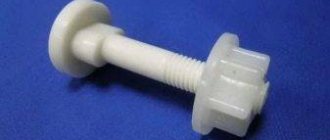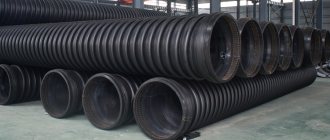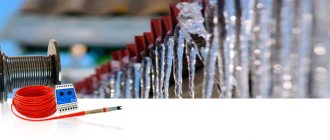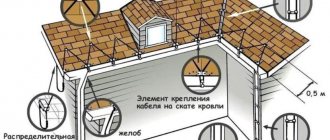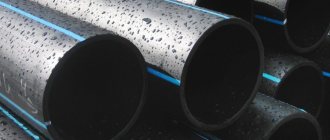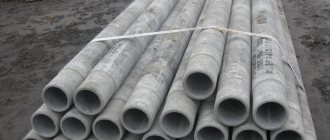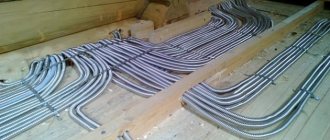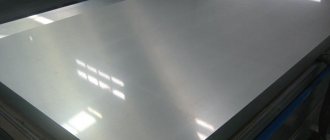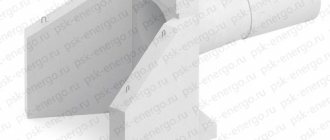Laying cables in pipes underground is a more labor-intensive undertaking than aerial (open method), however, the reliability of such a design in terms of safety is much higher. This method of laying cables is especially popular in summer cottages, where there is a possibility that it could be “borrowed”. Cable installation in pipes is carried out in accordance with the standards prescribed in the rules for electrical installations (PUE).
The use of pipes to protect cables increases the safety of electrical networks
Advantages of laying in the soil
Installation of cables in the soil is carried out using various types of pipes: metal, metal-plastic, low-pressure polyethylene (HDPE). This type of gasket has a number of advantages over the air method:
- laying the cable in a pipe ensures its protection from adverse weather conditions and will also reduce the likelihood of mechanical damage;
Helpful information! The cable laid underground is very easy to replace if necessary. To do this, you just need to dig out the communication and remove the old cable from the line, replacing it with a new one.
- this method eliminates the possibility of fire, which is a very important advantage, especially for houses made of flammable materials (for example, wood);
- additional protection of the wiring in the form of a pipe eliminates the possibility of damage to the cable by rodents;
- such communication (unlike air communication) is not visible and does not spoil the aesthetics of the site;
- in most cases, the cost of such cable installation is lower than with open installation.
Corrugated pipes
On sale you can even find varieties of such pipes with very large sections that are laid in concrete or cement screed.
Recommended pipe sizes for various purposes are:
- for installation of switches and sockets – 20 mm;
- for installation of lighting elements – 16 mm;
- laying a line between the boxes and distribution panels - 25 mm;
- for making connections between floors – 40 mm.
Let us note the most significant advantages of corrugated pipes for home use:
- electrical wiring will be reliably protected from mechanical damage;
- possibility of quick installation without additional elements;
- non-flammability of the material - thanks to this, the risk of fire of wires is eliminated;
- high-quality insulation of electrical wires;
- the flexibility of the pipe allows you to create a line of any configuration, passing along the shortest path.
What cables are allowed to be used?
According to GOST, it is allowed to lay cable wiring underground, which has certain technical characteristics. A desirable parameter for laying cables in a trench without the use of pipes is the presence of so-called armor . Armored cables, among other things, must also have high waterproofing properties. The installation of such cables can be carried out without protective pipes, however, the cost for them is higher than for budget options that are installed in pipe communications.
Special types of cables are used for underground installation
Let's consider the main types of cables that are allowed to be installed in the soil without protective pipes:
- AVBbShv. Armored cable with aluminum cores inside. The armor is represented by two layers of galvanized steel, covered with an insulating layer on top;
- VBBShv. This cable differs from the previous one only in the material from which the cores are made - it has a copper filling. In terms of other technical characteristics, VBBbShv is similar to AVBbShv. Both of these types are recommended for use for wiring electricity in summer cottages. Also, their properties make it possible to eliminate the use of protective pipes.
- PvBShv. This cable is also an armored type, however, unlike the previous two types, the insulating material of the product is cross-linked polyethylene. This material has high strength characteristics, so it is ideal for laying underground, but its cost is higher. PvBShv is often used in difficult climatic conditions.
In addition, other product options are suitable for underground wiring: AAShp, AAShv, AAB2l, etc. Such models of cable products can be used in soil that has normal acidity.
For soil containing active chemicals of various natures (salt marshes, swamps), the following cable models are perfect: AABL, AAShv, AAB2l, ASB, AAPL, ASPL, AAP2l, AAShp, AVBbShv, AVBbShp, APvBbShv, etc.
Laying a simple cable in a protective pipe will be cheaper than using armored wires
Together with protective pipes, armored cables provide high levels of communication reliability and have a long service life. But not every owner has enough money to equip such wiring. And even more so, the least profitable option is the use of armored cables and pipes. In this case, they use cheaper cable products laid in pipes.
The cable used for installation in underground pipes, as a rule, has a special marking - SIP (self-supporting insulated wire). This type of cable can be used when laying using the trench method only in conjunction with a protective pipe.
What pipes are used to lay cables in the soil?
Laying cables underground is safer than overhead wiring. Pipes that serve as a protective casing for cables can be made of different materials. Let's consider the main materials of such pipes and their features:
Metal . The metal pipe to protect the cable must have a cross-sectional area that is 2–3 times the diameter of the cable itself. The depth to which the cable is laid in a protective casing, as a rule, depends on the climatic characteristics of the region, namely, on the depth of soil freezing. If the freezing depth reaches the depth of the trench, then it is necessary to additionally secure the pipe to protect it from damage.
Important! Do not use steel pipes for power cables. This material is only suitable for control lines.
Asbestos-cement. Previously, such pipes were used quite often for the trench method of wiring installation, however, today they are used extremely rarely. Installation of such pipes is difficult due to their heavy weight. In addition, asbestos-cement products have low strength indicators and also emit substances harmful to human health. Asbestos cement products are carcinogenic and are not recommended by experts.
Asbestos-cement pipes are quite fragile, which is why their service life is relatively short
Plastic (HDPE, PVC, PP). Today, a plastic protective pipe for laying electrical wiring in a trench is the most popular option of all. This is due to the fact that plastic communications have a number of positive advantages:
- low weight;
- high strength characteristics;
- resistance to corrosive influences;
- high insulating properties;
- long service life.
Plastic pipes come in a wide range of sizes and other characteristics. If necessary, you can choose a product with a smooth or corrugated wall. The most popular plastic pipes are HDPE products, which come in the following varieties:
- light corrugated pipes;
- heavy corrugated pipes;
- halogen-free;
- smooth hard;
- products with two walls.
Application of thin-walled pipes
A few words about the specifics of products of this type. Since we are talking about technical products, its definition should contain numbers, and not a subjective assessment of belonging to one class or another. So: the range of thin-walled steel pipes includes products with a wall thickness of no more than 1.5 millimeters or if the value of the coefficient determined by the formula
Din. is the outer diameter, and S st. – wall thickness, lies in the range of 12.5...40.
A good example of the use of thin-walled metal products includes pneumatic and hydraulic drive systems in the automotive, aviation and shipbuilding industries.
Of course, the above-mentioned area of application for thin-walled steel pipes is far from the only one. They can be found in such industries as:
- construction;
- housing and communal services sector;
- furniture manufacturing;
- boiler houses of energy enterprises.
Architectural elements or decorative items can be made from steel pipes
In everyday life, these products are also not uncommon. But here they are most often used when engineering communications must have moderate strength, sufficient to withstand only low loads. In this case, we are talking primarily about a thin-walled steel pipe for electrical wiring.
Corrugated pipes for laying cables in the ground
Particular attention should be paid to corrugated pipes for wiring power lines in the soil. Such products can be of two types:
- unreinforced;
- reinforced.
Corrugated pipes are the best option for laying electrical cables underground
Reinforced corrugated pipes are characterized by increased strength. Strength is achieved thanks to special steel wire, which is equipped with reinforced models at the production stage.
Today, double-walled corrugated pipes are becoming increasingly popular. This product includes the following structural elements: a corrugated outer shell consisting of HDPE and a smooth inner shell made of high-density polyethylene (HDPE). A distinctive feature of such a pipe is considered to be a high coefficient of ring stiffness. Thanks to this, such models are able to withstand heavy loads. In addition, installation of the cable into the pipe is carried out without any difficulties, since the smooth inner wall made of LDPE simplifies the process.
The light weight of the pipe also facilitates its installation, and high thermal stability allows double-walled corrugated pipes to be used in different climatic zones. In addition, the positive qualities of double-walled models include: resistance to the destructive effects of corrosion, resistance to ultraviolet rays and a service life that can reach 50 years (in some cases more).
Features of laying cables in metal pipes
For wooden buildings (houses, bathhouses, etc.), it is recommended to lay protective pipes made of metal materials. Such materials include: iron or galvanized steel. The use of galvanized products is more preferable, as they have good resistance to corrosion.
Internal wiring in premises can be laid in metal corrugated and smooth pipes
It is recommended to use DKS pipes for laying cables indoors. The trench use of these pipes is undesirable, however, if such communication is temporary, then it can be done in the soil and from the DCS pipe. To connect individual route segments, as a rule, special threaded fittings are used. The use of such couplings greatly simplifies installation and reduces installation time.
Important! When laying such communications, you should take care of grounding. Grounding for such structures is a mandatory measure, which is specified in the relevant documentation.
In addition, it is worth remembering that the slope of the route is towards the electrical distribution panel. Pipes, as well as the joints between pipes, must be painted to protect communications from corrosion. Such structures are not suitable for indoor work, since painted pipes do not adhere well to concrete poured into the floor.
Regulatory documents
Characteristics of copper decorative pipe and additional elements for electrical wiring
The technology of electrical installation work is regulated by a unified set of building codes and regulations, which are mandatory for any organization, production or department.
The following provisions serve as regulatory documents:
- PUE (edition No. 7) - rules for the design of electrical installations for new and reconstructed buildings with equipment operating at voltages up to 500 kW.
- SNiP (2.08.01–89, 2.09.04–87) – regulations that prescribe general provisions, design standards, installation and work acceptance rules.
- PTB (153–34.0–03.150) – safety rules when carrying out electrical installation and debugging work.
The production of steel electrical pipes is regulated by GOST No. 10704–91, 10706–76 and the international standard CEI EN No. 50086–1. GOST contains a complete list of characteristics and technical requirements for the product.
The technical and operational characteristics of rigid smooth PVC pipes are regulated by the interstate standard adopted in 2014 - GOST 32126.1–2013. The old GOST 50827–95 is no longer valid.
Features of laying cables in plastic pipes
Installation of electrical cables in low-density polyethylene pipes has several features that are worth paying attention to. First of all, in order to exclude unforeseen circumstances, it is recommended to prepare a drawing of the future route.
It is advisable to fix the communication at certain intervals, which, depending on the specific case, can range from 60 to 80 cm. The structure is secured along its entire length with special staples or clips.
Pipes with cables inside should be securely fastened to all surfaces along which wiring runs.
In order to pull the power line through the pipe, special broaches are used, with which the pipe is equipped at the factory. If there is no broach, it can be replaced with ordinary metal wire.
Unlike a metal route, the elements of which are joined using threaded connecting elements, the joining of individual segments of a plastic pipeline is carried out using special soldering equipment. The electrical cable is connected using special couplings. In addition, if the communication is mounted vertically, it is recommended to slope it to eliminate the possibility of condensation accumulating in it. Compliance with the above rules will allow you to obtain a durable and reliable design.
Application of metal pipe products
When metal pipes are used for electrical wiring, there may be difficulties associated with pulling the cable through them. This can be solved in several ways. The simplest of them is to insert a steel wire into the channel, attach a cable to its end and then pull it inside.
If the pipe is long, then you can place a ball in it, to which a strong ribbon or thread is tied. To make it easier to move, talc is used. A steel wire is attached to the end of the tape and the air compressor pipe is placed in the hole, after which the device is turned on. The ball moves under pressure along the channel and draws the tape or thread along with it. To cut the product, use a grinder or a hacksaw.
To lay electrical wiring to sockets and switches, choose products with a diameter of 20 millimeters, for lighting fixtures – 16 millimeters, 25 millimeters for connecting distribution or switchboards and boxes, and for interfloor connections – 40 millimeters. The length of the channels, as a rule, ranges from 3 to 5 meters.
Construction of the trench
Arranging a trench is an important aspect of installing a power line into the ground. Many people turn a blind eye to this, however, the rules should still be followed. Let's consider the basic requirements that underground cable installation must meet:
- the pipeline must have a depth in the soil of no less than 70 cm. If installation is carried out in non-standard climatic conditions, this figure will be correspondingly higher;
- It is important to remember that the distance of the communication being laid to the foundation must be at least 60 cm. It is strictly forbidden to lay a route under the foundation ;
- The width of the trench is determined by the diameter of the pipe. In turn, the diameter of the pipeline must correspond to the number of cables. If several conductors are placed in the channel, the distance between them must be at least 10 cm;
- Before arranging a ditch, it is necessary to study the plan of a specific site. This is necessary in order to select the correct location of the trench. According to the PUE, the cable is laid in the pipe at appropriate distances from other communications (the route must be at least 2 m from the gas pipeline, and also no closer than 1 m from the water supply);
Construction of trenches must be carried out in accordance with the PUE; laying of warning tape is mandatory
Helpful information! In some cases, to strengthen such communication when the soil subsides, owners use ordinary bricks. It is not recommended to use hollow bricks for these purposes.
- It is imperative to put a tape on top of the route, which will warn that a power cable is laid here. After this, it is necessary to again fill in a layer of sand and earth (with a slide of 10–15 cm).
Requirements for underground installation
Absolutely all installation work on the electrical line that is associated with excavation work begins only after a special permit has been issued, giving the right to carry out the work .
This permit is drawn up by the customer in the executive bodies of local government and transferred to the contracting company.
The contracting company, on the basis of a permit, receives an appropriate warrant for excavation work from the owners of utility networks located in the immediate vicinity of the cable work.
It indicates the person who is responsible for the production process , the company that will restore the coating and representatives of the owner of the utility networks. According to the rules, they must be invited to the cable laying site before excavation work begins.
Design and installation documentation, an order and a copy of the notice must be stored at the work site where the cable work is performed until its completion.
It is rational to install underground electrical cables in residential areas along impassable sections of streets: under pedestrian sidewalks, annual plants and shrubs, so as to cause the least damage to public infrastructure and not interfere with street traffic in the event of repair work.
Particular care must be taken when laying trenches when crossing security zones of underground utility networks. Before starting work, the responsible person must mark the zones of their location according to the diagrams and in reality and mark the boundaries in the area of which it is prohibited to work with the use of earth-moving machines and the use of impact mechanisms.
The exact location of communications is determined by one-meter pits along the axis of the excavation being constructed. If underground objects are laid parallel to the cable being installed, pits are dug perpendicularly every 20 m. Their length must be 30 cm greater than the width of the excavation on each side. The depth of the pit must exceed the height of the excavation by 20 cm.
When installing electrical cables underground in parallel with various utility networks and other infrastructure, it is necessary to maintain a gap between them:
lines up to 10 kV - 100 mm;- 35 kV lines - 250 mm;
- control wires and lines 500 mm;
- the distance between power lines up to 10 kV and the control wire is maintained at least 100 mm, and between the electrical cable and the communication cable - over 500 mm;
- the gap between fiber optic communication lines and electrical cables up to 1 kV is 700 mm, and up to 6 kV - 1500 mm;
- the distance to forest areas should be at least 300 cm, from the tree - 200 cm;
- from the foundations of buildings - 60 cm.
Laying cables under the road
The laying of cables under the road in pipes is carried out with the permission of the organization on whose balance sheet the road is located. This point is especially relevant for routes located in populated areas, since other communications may pass under them. If laying under the road is carried out in a holiday village, then such an event must be agreed upon with the administration.
The rules for installing a power line in a protective casing under an unpaved road surface are the same as for conventional installation. The depth, arrangement of the sand cushion, backfill and other parameters coincide with the usual installation of communications. The electrical cable is laid in a pipe under a paved road, usually using the puncture method. Puncture involves the use of special equipment and is a trenchless method of arranging communications, however, the cost of such work is quite high.
How to properly lay a cable in the ground?
First of all, it is necessary to draw up a plan for laying the power cable in the protective pipe. Next, a phased installation of communication is carried out. Let's consider the process of installing communications by digging a trench:
- First, the pipe is laid at the bottom of the trench. Laying is done on soil with a sand cushion. The sand layer should be at least 10 cm.
- Next, the cable is pulled using a wire.
- At the third stage, the communication is covered with a layer of sand (so that the pipe is not visible).
- After this, we fill the trench with a layer of earth and compact it with our feet. The layer should be approximately 15 cm.
- We place warning tape on top of the trench, which performs a warning function.
- Then the channel is completely filled with earth and compacted.
Note! After installation, it is necessary to carry out a test measurement of the cable insulation.
This kind of work can be done without much difficulty with your own hands. In order not to encounter difficulties when laying cables in a pipe, it is recommended to carefully consider the issue and study all the rules and regulations associated with the installation of such communications. In addition, it is recommended to contact an electrician who will advise you on this issue.
